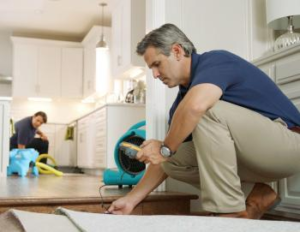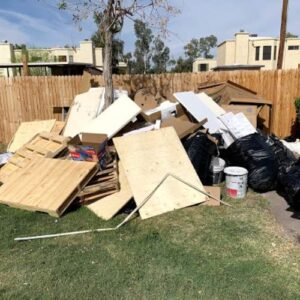Water Damage Restoration Utah is a complicated and involved process. Porous materials like insulation, drywall, and carpeting quickly absorb excess moisture, creating the perfect breeding ground for bacteria, mold, and other pathogens that can cause serious health problems.
The first step in the water restoration process is assessing the damage and removing standing water. Then, it’s time to sanitize the area.

It’s important to act quickly to reduce damage, minimize health risks, and protect your belongings when water damage happens. Timely water restoration also helps prevent mold and other serious issues and can save you money in repair costs. Water damage restoration professionals start the process by assessing the situation and developing a plan. Then, they clean and sanitize the affected areas to remove any bacteria or other contaminants. They may use professional-grade disinfectants to clean surfaces and materials, as well as air scrubbers to sanitize the air.
The next step is removing the water and drying the affected area. This may be done using a truck-mounted water extractor, industrial-powered dehumidifiers, or other tools. Depending on the amount of water and type of material affected, this can take several days. The water removal process should include structural drying to avoid damage, unsalvageable water damaged contents, and the disposal of any unwanted materials. This process is called water mitigation and is one of the most critical steps in a successful water restoration project.
During this stage, experts also disinfect the affected area and its contents. This includes surfaces such as floors and walls, and personal belongings such as furniture and clothing. It can also involve sanitizing toilets and other appliances and sanitizing the entire building to ensure it is safe for habitation once again.
Cleaning and sanitizing also removes any harmful bacteria that can cause illness in people and animals. This is especially important in cases of category two or three water damage, which involves contaminated water. This may include sewage backups, river or stream brackish water, flooding seawater, or any other contaminated water. Category three water damage requires special safety equipment and should only be cleaned by experts trained in dealing with such hazardous materials.
Water damage restoration is a long and complex process. It is important to work with a certified water damage restoration company that follows industry standards and keeps up with the latest technology and tools. An IICRC-certified professional can help you restore your property to its pre-loss state and minimize the risk of permanent damage.
Water damage restoration professionals use cleaning agents and techniques to remove dirt, debris, and contaminants from surfaces and materials. They also sanitize and deodorize to ensure a healthy environment for occupants. This step is especially important in cases of category 2 or 3 water damage, which may involve contaminated sources. Professionals can use specialized cleaning and sanitizing equipment to eliminate bacteria, fungus, and other harmful substances.
After assessing the water damage, water damage restoration experts will use high-powered drying equipment to extract as much water as possible from the affected areas. This includes submersible pumps, wet/dry vacuums, industrial-strength extractors, and more. They may also use dehumidifiers and commercial air movers to speed up the drying process. This equipment is often more powerful than what homeowners can access and is essential for preventing further damage to the property and its contents.
Once the water is removed, the restoration experts will inspect the area to see how bad the damage is. They will check for safety hazards like electrical outlets and cords, and they will look at the damage to the building materials like wood, drywall, and insulation. They will use moisture sensors and meters to determine the moisture content of these materials. If the moisture levels are too high, these materials will need to be removed and replaced.
One of the most serious consequences of untreated water damage is structural damage. Unchecked, this can lead to rotting, warping, and even collapse. During the inspection and cleanup phase, water damage restoration experts will evaluate the condition of the structural components in the home or business to determine whether they can be salvaged or need to be replaced.
Another major consequence of unchecked water damage is mold and mildew. These microscopic organisms thrive in damp and dark environments and can cause significant health problems for occupants. To prevent mold and mildew from spreading, water damage restoration professionals clean and sanitize the property with antimicrobial solutions, then dry it thoroughly. In addition to sanitizing and drying, water damage restoration experts may also use ozone generators to deodorize the space.
When it comes to water damage restoration, drying is one of the most important steps. Whether the damage is caused by a flood or burst pipes, it’s important to have professionals with drying equipment to ensure that all areas are dry before beginning repairs.
This is a crucial step because wet materials can create a breeding ground for bacteria and mold. Not to mention, they can also lead to structural damage and deterioration over time. Professionals use a variety of drying equipment, including dehumidifiers and air movers, to remove moisture from affected materials until they are fully dry. They can also use new technology, such as moisture maps, to help determine the best course of action for a particular situation.
Once the inspection is complete, it’s time to begin the actual water damage restoration process. This begins with water removal, which is typically done using truck-mounted extraction equipment. This allows them to quickly remove the majority of the water and expedite the drying process.
At this point, they may also remove any materials that cannot be restored, such as drywall and carpeting. This is a critical step because it can prevent damage to the building structure and save the owner money on future repairs. Additionally, it can protect the health and safety of occupants by preventing the spread of mold and bacteria.
It is important to remove all the water as quickly as possible, as it can cause serious and costly damage if left unattended. This is especially true for commercial properties, where the loss of space and productivity can be devastating. Water damage restoration companies can speed up the drying process by using a combination of methods, including high-powered fans and dehumidifiers. In addition, they can use advanced technology, such as moisture meters and thermo-hygrometers, to identify and monitor moisture levels throughout the property.
Once all the water is removed, the next step is to dry out the rest of the building. This can be a difficult task because it takes a long time for wood, drywall, and other building materials to dry out. It is also important to note that different types of materials require different drying techniques. For example, specialty rugs and electronics need to be dried differently than oak tables or drywall.
When water penetrates the building materials of your home, it can get deep into drywall and insulation. This can cause rot and even collapse the structural elements of your house. If you want to avoid this kind of disaster, it’s important that you call in the professionals right away. Water damage restoration experts are trained to quickly and thoroughly remove the water and dry the area.
They have special tools and equipment that will help them determine the extent of the damage. They’ll also test the moisture content of the materials in your home to see if they can be saved. During this phase, they’ll use specialized personal protective equipment such as N-96 respirators and protective gloves to protect themselves from contaminants.
If necessary, the water restoration experts will remove damaged building materials like drywall and carpeting to expedite the drying process. This will save you the cost of replacing these materials and prevent the spread of mold, mildew, or other health hazards. Mold and mildew thrive in damp, dark environments and can pose serious health risks for occupants of a home or business.
A reputable restoration company will be licensed and insured, and they should use sustainable cleaning and drying techniques that are environmentally friendly. This will not only reduce your carbon footprint, but it will also ensure that the rest of your home or business is properly dried and sanitized.
Finally, a reputable restoration company should have an excellent track record and references. It’s important to find out if their customers were satisfied with the services they received and if they were able to get back into their home or business without too much delay. They should be able to explain their cleaning and drying processes and answer any questions you may have.
Water damage restoration is a complex job that requires specialized skills, specialized equipment, and knowledge of effective techniques. Leaving it unattended can lead to extensive and costly property damage. In addition, standing water creates the ideal environment for mold and mildew to grow, which can pose a serious health risk for occupants of a home or building. By addressing water damage promptly, you can avoid costly repairs and restore your life to normal.

